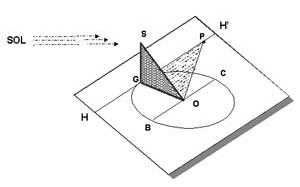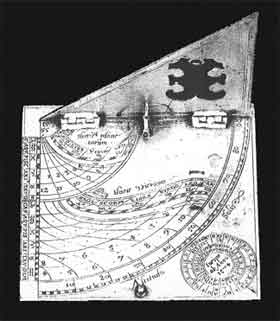|
The Shadow Instrument
In his works, Pedro Nunes suggested various instruments that he imagined could be useful for astronomical navigation. What was essential was the precise measurement of the altitude of the sun or of other celestial bodies, namely the North Star. Using this measurement, pilots calculated the latitude of the place where they were observing. It is highly likely that Pedro Nunes never had any of his instruments constructed nor that he used any of them because, as a mathematician interested in theoretical problems, his creations, albeit imaginable and useful, were above all ingenious applications of mathematics and geometry. He left it to others to apply and test his ideas. From his inventions, there are three that endured and that contributed significantly to the progress of scientific instrumentation: the Nonius, the Nautical Ring and the Shadow Instrument, several specimens of which are known to have been used.
Among the instruments suggested by Pedro Nunes used to measure the altitude of the sun, there was one that become famous for the application given to it by D. João de Castro (1500–1548), the great travelling intellectual of the sixteenth century. It is a simple instrument, similar to a sundial, but with an ingenious innovation that made it possible to measure altitudes directly by using the shadows projected by the sun.
With modern technology, it is easy to construct an instrument that can instantly read altitudes. All that is needed, for example, is to build a base with an upright stake and to make markings on the base that will transform the length of the shade into angular height. However, this means that the marks cannot be spaced evenly apart as the length of the shadow is not proportional to the angular height [1] — when the sun is almost directly overhead, the length of the shadow varies very little; as it gets closer to the horizon, the shadow increases rapidly. Duly grading a scale that translated the length of the shade into angular height was no easy task to be entrusted to handicraftsmen of that time. If they already had difficulty in dividing a right angle into 90º, they would have even greater problems to build an uneven graduated scale. Pedro Nunes therefore looked for a way to transfer the shadow of the sun to a scale graduated in degrees on a flat base. If we think a little about how to resolve the problem, we realise that it is not easy to invent a solution. Nunes’ instrument was of great simplicity yet it was an enormous geometrical invention.
The base was a plate, normally square, where a circle was inscribed and a tangent to the circle was drawn. A plate similar to a style or gnomon, such as that of sundials, was placed vertically on the circle. This plate had the form of an isosceles rectangle striangle, with the cathetus equal to the radius of the circle. The triangle had one cathetus resting on the radius of the circle which it touched on the straight tangent, as can be seen in the figure. A diameter parallel to the tangent was drawn on the circle and the circumference was graduated from 0º to 90º, in the direction of the diameter to the tangent point [2].
In order to measure the altitude of the sun, the base of the instrument was placed horizontally. The base was then rotated until the edge of the shadow of the triangle coincided with the straight tangent line. The height of the sun was read directly on the graduated circle.
 |
|
Figure 1. The shadow instrument of Pedro Nunes is made up of a horizontal base where a plate in the form of an isosceles rectangle triangle was fixed vertically. One of the cathetuses of the triangle coincides with the radius OG, perpendicular to tangent HH’, another remains vertical on point G. The diameter BOC is marked parallel to tangent HH’ and the circumference of B to G and from C to G is graduated. To measure the height h of the sun, the device is rotated until the shadow of cathetus GS, perpendicular to the base, aligns itself with tangent HH’. Angle h is equal to the horizontal angle h’ as triangles OGP and SGP are equal (both are rectangles, both have a cathetus in common, GP, and two equal ones: SG = OG). Angle h’’, in turn, is equal to h’, as they are both internal alternate angles in parallels HH’ and BC.
|
|
The geometrical principle of this instrument is simple, but only once it has been discovered. The rays of the sun make an angle with the horizontal plan, which corresponds to the angular height of the celestial body. By placing the plate in such a way as to make the shadow coincide with the straight tangent, this angle is transferred to the horizontal plate, where it is read directly. The geometrical demonstration is explained in Figure 1.
Pedro Nunes called his device “instrumento jacente no plano” and it was D. João de Castro who called it the “shadow instrument”. This nobleman informs us of its practical use in his Roteiro de Lisboa a Goa, a work he published in 1538. In his journey he repeatedly tested this device, as well as another one, also referred to as shadow instrument, and which was designed to calculate the magnetic declination, i.e. its deviation in relation to true north. This other instrument was also suggested by Pedro Nunes, but Francisco Faleiro, who, along with his brother Rui, was associated to the journey of Fernão de Magalhães, had presented the same proposal prior to this [3].
D. João de Castro’s main objective was to put to the test a rule which Pedro Nunes had suggested for measuring “the altitude of the sun at any time of the day” and which was based on two extra-meridian solar heights, i.e. not taken at the mean solar day.
A week after having left Lisbon on his first journey to India, the Portuguese nobleman measured the height of the sun at two different moments and calculated his location at a northern latitude of 29º 30’. Shortly afterwards, the pilot obtained 29º 20’ by the normal means of measuring the height of the sun at noon and was “very amazed”, as D. João de Castro relates, on opening the “escrito cerrado” which Pedro Nunes had sent to him, to see in it the correct indication of the latitude. Pedro Nunes’ procedure and the measurements of the shadow instrument produced good results several times throughout the journey, leading Castro praise it unceasingly. Despite this, however, the instrument did not become widespread among pilots and news of it being used in navigation only appeared more than one hundred years later when another author, António Carvalho da Costa, resuscitated it with some changes in his work Via Astronómica, published in Lisbon in 1676.
|
 |
|
|
|
Figure 2. Instrument derived from Nunes original idea, manufactured in London by Humphrey Cole (1530?–1591). It is part of the collection of the Kunstgewerbemuseum of Berlin (K.4670)
|
The idea, however, was not lost, as can be observed by some instruments which survived. There are known to be specimens in the Science Museum in London and in the Kunstgewerbemuseum in Berlin. As can be seen in Figure 2, Nunes’ instrument was simplified by instrument makers, leaving only a quarter of a circle, and several scales were added which enabled it to be used also as a sundial.
Nuno Crato
[1] But rather to its co-tangent.
[2] The altitude of the sun was measured directly using this graduation. If one wished to measure zenith distances, the circle would be graduated from the tangent point to the diameter.
[3] Nunes’ proposal of an instrument to measure magnetic declination was presented in the Treaty zem defensam of the ship’s log-book, included in the Tratado da Esfera, of 1537. His proposal corresponds to the second of four processes presented by Francisco Faleiro in 1535 in his Tratado del Sphera. The instrument, like many others used in navigation, is referred to in detail in Luís de Albuquerque, Instrumentos de Navegação, Lisbon, Comissão Nacional para as Comemorações dos Descobrimentos Portugueses, 1988 and António Estácio dos Reis, Medir Estrelas — Measuring Stars, Lisbon, CTT Correios de Portugal, 1997.
|
|


